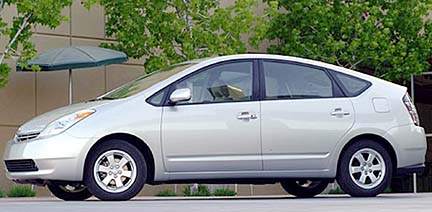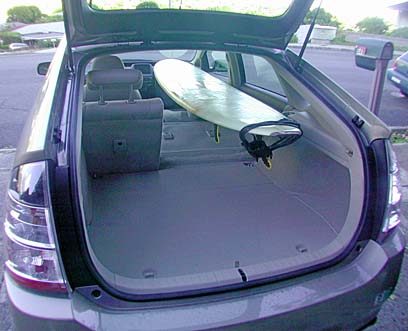
TIM RYAN / TRYAN@STARBULLETIN.COM
The 2004 Prius has been completely restyled.
Toyota hybrid doesn’t
skimp on comfort
I test-drove the original Prius -- Toyota's first alternative energy car in the form of a gas-electric hybrid -- three years ago, and that pretty much dispelled the myths about electric-powered, alternative fuel vehicles, among them images of enormous batteries and the possibility of being electrocuted.
What I discovered then was that an electric-gas vehicle could do anything other cars in its compact class could do, with the exception of doing 60 mph in 10 seconds or having to fill up the gas tank every 275 miles.
Practical concerns stopped me from buying one of the $20,000 vehicles. It didn't come in a hatchback with rear seats that folded flat. That meant there was no way I could slide a surfboard, or other bulky items, inside the car.
All that's changed with the 2004 models that hit Toyota showrooms last Friday, and those with an eye for practicality, frugality in the wake of high gas prices and concern for the environment may find the Prius worth a second look.
I had an opportunity to drive a loaner all over the city, on errands, and to the North Shore to surf. (It took barely a gallon of gas to get from East Oahu to Haleiwa and back.)
The new car, now a midsize with nearly as much interior room as a Camry, is as roomy as a family sedan. Two adults can sit comfortably in back. More important, my 9-foot-4 longboard fit easily with inches to spare. Younger surfers prone to living in their cars may even find there's enough room to sleep comfortably.
The car is more powerful than the first version, with an all-new drive system that offers zippier acceleration and greater fuel efficiency. Toyota says its new hybrid's zero-to-60-mph time has dropped to 10 seconds from 12.7 seconds. And it goes 600 miles on the 12-gallon tank between fill-ups.
TIM RYAN / TRYAN@STARBULLETIN.COM
The car is equipped with a dashboard display that illustrates power flow and is used to control temperature and audio systems.
As for options, there are a DVD-based navigation system and a "Smart Key" entry and start system.
New metallic accents on the vents, center console and doors brighten the car's appearance. The cluster of gauges are still positioned toward the center of the dashboard but are larger for easier viewing.
And surprise, surprise: The new Prius carries the same base price of $20,000, though with options the price can climb another $5,000.
Toyota had combined a small gasoline engine with the efficiency and cleanliness of an electric motor, so the Prius' hybrid power plant offered excellent mileage and clean emissions without ever needing to be plugged in to an electrical outlet.
Prius now has what Toyota calls a Hybrid Synergy Drive, which can run solely on electricity, gas or a combination of both. Its 1.5-liter gas engine produces 76 horsepower, six more than before.
The Hybrid Synergy Drive uses a 50 percent more powerful 50-kilowatt drive motor operating at up to 500 volts. In addition, the generator in the new Prius has a higher peak operating speed that increases electric-mode operation in city and freeway slow-and-go operation.
I found acceleration quick off the block, and the Prius' EPA mileage still registers at a combined city-highway rating of 55 miles to the gallon. The 2000 Prius got as much as 52 miles to the gallon in the city. The new Prius gets more miles per gallon in the city than on the highway, 60 mpg and 51 mpg, because the electric engine powers the vehicles at lower speeds but gas kicks in on the highway.
TIM RYAN / TRYAN@STARBULLETIN.COM
The Prius 2004 is now roomy enough to fit a surfboard.
Prius' exhaust emissions have been reduced by 30 percent over the previous model, earning it both SULEV (Super Ultra Low Emission Vehicle) and PZEV (Partial Zero Emissions Vehicle) ratings.
Fuel economy and environmental friendliness don't mean creature comforts are sacrificed. My car had a six-disc, multispeaker CD-cassette player, cold-as-ice air conditioner and rear wipers.
The ungainly column shifter used in the earlier Prius is replaced by a much smaller, easier-to-use lever to the right of the steering wheel. Instead of the usual ignition key, the Prius uses a fob that slides into the dashboard. Push the "start" button, wait a second for the computer control units to light, push the "P" for Park button and you're off.
An optional keyless system allows you to automatically unlock the doors and start the car, as the computer automatically senses the fob's presence. Same for opening the rear hatch.
The engine is so quiet I thought several times it hadn't started.
Like the earlier Prius, the information display in the center of the dash shows a picture of the power flow between gas and electric engines, or detailed charts of current and overall fuel consumption. The screen also is used to adjust the climate and audio system control.
For safety there are optional side airbags for front passengers, head curtain airbags that cover the front and rear, and a Vehicle Stability Control system. All models come standard with anti-lock brakes, a tire pressure warning system and traction control.
One complaint: Seats could be a bit more form-fitting.
My final verdict is a major thumbs up, in part because of what my wife called the addition of "hatchback practicality," though she didn't care for the car's shape, which didn't bother me. We both loved the Prius' environmental friendliness and practicality. Imagine driving to the North shore and back for less that $2.50.
Oh, and it's fun to drive.
Click for online
calendars and events.



